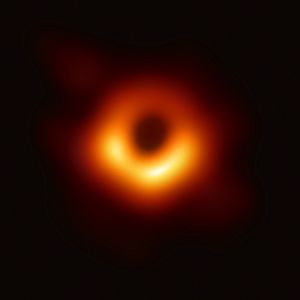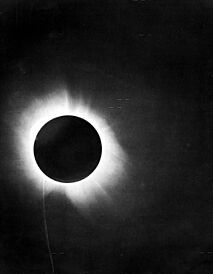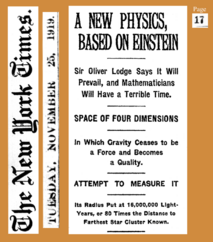History of general relativity facts for kids
General relativity is a huge idea about gravity that Albert Einstein developed between 1907 and 1915. It changed how we understand the universe! Before Einstein, people thought gravity was a force that pulled objects together, like Isaac Newton described. But Einstein had a different idea.
According to general relativity, gravity isn't a pull. Instead, very heavy objects like planets and stars bend or warp the fabric of space and time around them. Imagine a bowling ball on a stretched rubber sheet; it makes a dip. If you roll a marble nearby, it will curve towards the bowling ball because of the dip. That's kind of how general relativity explains gravity!
Einstein's theory explains things Newton's law couldn't. For example, it perfectly explains tiny wobbles in the orbit of Mercury. General relativity also predicted amazing new things. These include gravitational waves (ripples in space-time), gravitational lensing (light bending around massive objects), and gravitational time dilation (gravity affecting how fast time passes). Many of these predictions have been proven true by scientists.
General relativity is now a super important tool in modern astrophysics. It helps us understand black holes, which are places where gravity is so strong that nothing, not even light, can escape. This theory also forms the basis of the Big Bang model, which describes how our universe began.
Contents
How General Relativity Was Created
Einstein's Early Ideas
In 1907, while working at a patent office, Einstein had what he called his "happiest thought." He realized that gravity could be connected to how things move. He thought that if you are falling freely, you wouldn't feel gravity. This idea is called the equivalence principle. He wrote about it in an article in 1908. In this article, he also predicted that time would pass differently depending on how strong gravity was.
In 1911, Einstein wrote another article. He imagined a box accelerating upwards in space. He said it would feel just like a box sitting still on Earth in a gravitational field. He figured out that clocks at the top of the accelerating box would run faster than clocks at the bottom. This meant that time passes at different rates depending on your position in a gravitational field.
That same article also predicted that light would bend when it passed by huge objects, like the Sun. Einstein encouraged astronomers to try and observe this during solar eclipses. This is because during an eclipse, stars near the Sun would become visible.
Astronomers tried to test Einstein's idea. In 1912, Charles D. Perrine was the first astronomer to try and observe light bending during a solar eclipse in Brazil. Unfortunately, heavy rain stopped any observations. In 1914, Perrine, Erwin Finlay-Freundlich, and W. W. Campbell tried again during an eclipse in the Russian Empire. But clouds and the start of World War I prevented clear results.
It was actually good that these early attempts failed! The amount of light bending Einstein calculated in 1911 was too small. When he finished his full theory in 1915, he corrected his math. He then predicted the correct amount of light bending, which was twice as much. Later observations in 1919 and 1922 confirmed this corrected prediction.
Einstein also thought about a spinning disk. He realized that if you measured the circumference and radius of a spinning disk, the math for pi (π) wouldn't work out as expected in normal flat space. This made him think that space itself could be curved. This idea led him to study Riemannian geometry, a type of math that describes curved spaces.
Developing the Full Theory
In 1912, Einstein returned to his old university, ETH Zurich, as a professor. There, his friend Marcel Grossmann taught him about Riemannian geometry. With help from mathematician Tullio Levi-Civita, Einstein started using this advanced math to describe gravity. By late 1915, he had published his complete general theory of relativity. This theory explains gravity as the way matter distorts the structure of spacetime, which then affects how other matter moves.
During World War I, it was hard for scientists from different countries to share their work. But some of Einstein's ideas reached the United Kingdom and the United States thanks to physicists in the Netherlands, like Hendrik Lorentz.
In May 1919, a team led by British astronomer Arthur Stanley Eddington confirmed Einstein's prediction. They photographed a solar eclipse from Brazil and an African island called Príncipe. Their photos showed that starlight did indeed bend as it passed the Sun. This was huge news! Many famous scientists, like Max Born and Paul Dirac, called general relativity one of the greatest scientific discoveries ever.
Some people later questioned Eddington's photos, saying they weren't perfectly clear. But more accurate observations later confirmed that light does bend as Einstein predicted.
Testing the Theory
The first big proof for general relativity came from its correct prediction of Mercury's orbit. Newton's theory couldn't fully explain a tiny wobble in Mercury's path, but Einstein's could.
Then, in 1919, Arthur Stanley Eddington's eclipse expedition confirmed that the Sun's gravity bends starlight. This really helped establish general relativity as a strong theory. Since then, many other observations have matched Einstein's predictions. These include studies of binary pulsars (two neutron stars orbiting each other), observations of radio signals passing the Sun, and even how the global positioning system (GPS) works. GPS satellites have to account for general relativity to give accurate locations!

The theory also predicted gravitational waves. These are like ripples in the fabric of spacetime that travel outwards from a source. On September 14, 2015, scientists made the first observation of gravitational waves. They came from two black holes crashing into each other! This amazing discovery happened 100 years after Einstein published his theory.
Another incredible moment happened on April 10, 2019. The Event Horizon Telescope team published the first-ever image of a black hole! It was the supermassive black hole at the center of a galaxy called Messier 87.
Other Ideas About Gravity
Scientists have tried to find other theories of gravity or make small changes to general relativity. But so far, general relativity has passed every test with flying colors.
However, general relativity doesn't fit perfectly with quantum mechanics. Quantum mechanics is the theory that describes the tiny world of atoms and particles. Scientists are still working on a "theory of everything" that would combine gravity with quantum mechanics. This future theory is often called quantum gravity, and ideas like string theory are part of this search.
The Golden Age of General Relativity
The years from about 1960 to 1975 are often called the "golden age of general relativity." During this time, the study of general relativity became very popular in theoretical physics. Many exciting ideas and terms, like black holes and gravitational singularities, were introduced. At the same time, the study of how the universe began, called physical cosmology, also became very important, and the Big Bang theory became widely accepted.



